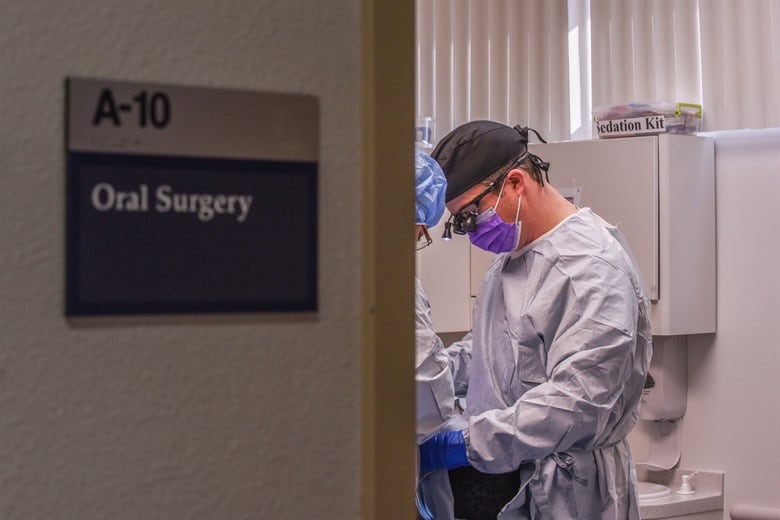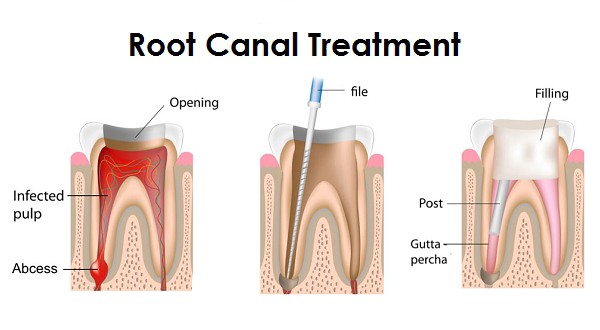Root canals are a common dental procedure that people may need to undergo at some point in their lives.
However, many people are hesitant to get a root canal because of the fear of pain.
The question “Are root canals painful?” is a common one, and the answer is not as straightforward as a simple yes or no.
During a root canal, the inflamed or infected pulp of a tooth is removed and replaced with a filling.
The procedure is performed under local anesthesia, which numbs the area around the tooth, so the patient should not feel any pain during the procedure.
However, some people may experience discomfort or sensitivity in the days following the procedure.
The amount of pain experienced can vary depending on the individual’s pain tolerance and the complexity of the root canal.
It is essential to note that while some people may experience pain after a root canal, it is usually manageable with over-the-counter pain medication.
In rare cases, a person may experience severe pain or other complications after a root canal, and they should contact their dentist immediately.
Overall, while root canals may have a reputation for being painful, with proper anesthesia and pain management, most people should not experience significant pain during or after the procedure.
Understanding Root Canals
Root canal treatment is a dental procedure that is used to relieve pain caused by an infected or abscessed tooth. During the root canal process, the inflamed pulp is removed.
The surfaces inside the tooth are then cleaned and disinfected, and a filling is placed to seal the space.
This procedure is often necessary when the pulp inside the tooth becomes infected or inflamed due to decay, trauma, or other reasons.
The pulp is the soft tissue that contains nerves, blood vessels, and connective tissue inside the tooth.
When the pulp becomes inflamed or infected, it can cause pain, sensitivity, and swelling. If left untreated, the infection can spread to the surrounding tissues and cause further complications.
Root canal treatment is usually performed by a dentist or an endodontist, who is a specialist in treating the pulp and nerves inside the teeth.
The procedure typically involves several steps, including:
- Administering local anesthesia to numb the affected tooth and surrounding area
- Creating a small opening in the top of the tooth to access the pulp chamber and root canals
- Removing the infected or inflamed pulp using small instruments
- Cleaning and shaping the root canals to prepare them for filling
- Filling the root canals with a biocompatible material, usually a rubber-like material called gutta-percha
- Sealing the opening in the tooth with a temporary or permanent filling

Root canal treatment is generally a safe and effective procedure that can help save a damaged or infected tooth.
While some people may experience mild discomfort or sensitivity after the procedure, most patients report that root canals are not painful.
In fact, root canal treatment is often less painful than the symptoms of the infection or inflammation that led to the procedure in the first place.
It is important to note that delaying or avoiding root canal treatment can lead to more serious complications, such as the spread of infection to other parts of the body.
If you are experiencing tooth pain or other symptoms of an infected or inflamed pulp, it is important to seek prompt dental care to determine if root canal treatment is necessary.
The Procedure of Root Canal
Root canal treatment is a common dental procedure that is used to treat an infected or damaged tooth.
The procedure involves removing the damaged or infected pulp from the tooth’s root canal and filling it with a special material to prevent further infection.
The procedure typically requires two or more visits to the dentist or endodontist. During the first visit, the dentist will numb the area around the affected tooth with a local anesthetic.
Once the area is numb, the dentist will make a small hole in the top of the tooth to access the pulp chamber.
Next, the dentist will use small, specialized tools to remove the damaged or infected pulp from the tooth’s root canal.
The dentist will then clean and shape the root canal to prepare it for the filling material.
After the root canal has been cleaned and shaped, the dentist will fill it with a special material, usually gutta-percha, to prevent further infection.
The dentist will then seal the opening in the tooth with a temporary filling.

During the second visit, the dentist will remove the temporary filling and replace it with a permanent filling or crown. In some cases, a dental crown may be necessary to provide additional support for the tooth.
While the root canal procedure can be uncomfortable, most patients experience little to no pain during the procedure.
After the procedure, patients may experience some discomfort or sensitivity in the affected tooth for a few days, but this can usually be managed with over-the-counter pain medication.
Overall, root canal treatment is a safe and effective way to treat an infected or damaged tooth and restore its function.
Pain During Root Canal Procedure
Root canal procedures are commonly associated with pain and discomfort.
However, with modern advancements in dentistry, most patients experience little to no pain during the procedure.
Anesthesia and Pain Management
Before the procedure, the dentist will administer local anesthesia to numb the area around the tooth being treated.
This will help to ensure that the patient does not feel any pain during the procedure.
In some cases, the dentist may also prescribe pain medication to be taken before or after the procedure to manage any discomfort.
During the procedure, if the patient experiences any discomfort, they should inform the dentist immediately.
The dentist can then administer additional anesthesia or take other measures to ensure the patient’s comfort.
Post-Procedure Discomfort
After the root canal procedure, patients may experience some discomfort and sensitivity in the treated tooth.
This is normal and can usually be managed with over-the-counter pain medication. In some cases, the dentist may prescribe stronger pain medication.
It is also important to avoid chewing on the treated tooth until it has been fully restored with a filling or crown. This will help to prevent any further damage or infection.
Overall, while root canal procedures may have been associated with pain in the past, modern dentistry techniques and pain management options have made the procedure much more comfortable for patients.
Factors Influencing Pain
Root canal treatment has a reputation for being a painful procedure, but the reality is that it is usually not as bad as people think.
However, there are certain factors that can influence the amount of pain a patient experiences during and after the procedure.
Individual Pain Tolerance
One of the most significant factors that can influence the level of pain a patient experiences during a root canal is their individual pain tolerance.
Some people have a higher pain threshold than others, which means they may not feel as much discomfort during the procedure.
Conversely, those with a lower pain tolerance may find the procedure more uncomfortable, even with the use of local anesthesia.
Severity of Infection
The severity of the infection can also impact the amount of pain a patient experiences during a root canal.
In general, the more severe the infection, the more likely it is that the patient will experience discomfort during and after the procedure.
This is because the inflammation and swelling associated with a severe infection can make it more difficult for the anesthesia to work effectively.
In addition to these factors, it is worth noting that advances in dental technology and anesthesia have made root canal procedures much less painful than they used to be.
Patients today can expect to experience minimal discomfort during the procedure and a relatively quick recovery period.
Methods to Alleviate Pain
Root canals are a common dental procedure that can relieve pain caused by an infected or abscessed tooth.
While the procedure itself is not typically painful, some people may experience discomfort or pain afterwards.
Here are some methods to alleviate pain after a root canal:
Medication
After a root canal, your dentist may prescribe pain medication to help manage any discomfort.
Over-the-counter pain relievers such as ibuprofen or acetaminophen can also be effective.
It is important to follow your dentist’s instructions regarding dosage and frequency of medication.
Home Remedies
There are also several home remedies that can help alleviate pain after a root canal.
Applying a cold compress to the affected area can help reduce swelling and numb the pain.
Some people find that moist heat can also help relieve pain. You can place a small piece of cloth soaked in warm water or use a cloth soaked in an herbal tea directly on the tooth.
Leave it on until the cloth is no longer warm and repeat this three or four times a day.
It is important to avoid chewing on the affected tooth until it has been fully restored.
Eating softer foods that are high in vitamin A and C, such as eggs, cooked carrots, and sweet potatoes, can help promote healing and reduce inflammation in the root canal area.
In summary, there are several methods to alleviate pain after a root canal, including medication and home remedies.
It is important to follow your dentist’s instructions and take any prescribed medication as directed. If you experience severe pain or swelling, contact your dentist immediately.
Preventing the Need for Root Canals
Root canals can be a painful and expensive dental procedure.
Fortunately, there are steps that can be taken to prevent the need for root canals.
Regular Dental Checkups
Regular dental checkups are crucial for maintaining good oral health and preventing the need for root canals.
Dentists can identify early signs of decay and infection and treat them before they progress to the point where a root canal is necessary.
It is recommended that individuals visit the dentist every six months for a routine checkup and cleaning.
Good Oral Hygiene
Good oral hygiene is also essential for preventing the need for root canals.
Brushing twice a day with fluoride toothpaste and flossing daily can help remove plaque and prevent tooth decay.
In addition, using an antiseptic mouthwash can help kill bacteria that can lead to infection.
Other tips for maintaining good oral hygiene include:
- Limiting sugary and acidic foods and drinks
- Drinking plenty of water
- Chewing sugar-free gum to stimulate saliva production
- Using a fluoride mouthwash or toothpaste to strengthen tooth enamel
By following these tips, individuals can help prevent the need for root canals and maintain good oral health.
Some Common Misconceptions About Root Canals
Let’s dispel some of the myths surrounding root canals:
Does a root canal have to hurt? – We’ve looked at this in detail – it absolutely doesn’t! Work with your dentist to make your root canal treatment as pain-free as possible.
Will I be unable to eat for days/weeks afterwards? – The effect on your eating is no more than it would be were you to have a filling. Simply avoid the area of the mouth that you’ve had the treatment in, and you will have no problem eating in the time after the surgery.
It’ll hurt for weeks after, right? – No! Normal paracetamol and ibuprofen is more than enough to keep pain at bay, and if you avoid very hot or very cold foods the day of your surgery, within 24 hours you’ll start forgetting you’re supposed to be in pain.
It’s easier to get the tooth taken out than have root canal surgery. – This certainly isn’t true. Your mouth is designed to have a certain number of teeth in it – there’s no doubt that your oral health is at its best when you have all the teeth you’re supposed to have.
Many people feel it will be easier to have an extraction, then a bridge or an implant fitted rather than have root canal surgery, but the truth is that having a root canal is much easier, quicker and simpler.
The procedure will take hours! – Many dentists will split the procedure up into two visits, especially if you struggle being at the dentist for long periods of time.
Even if you have the whole procedure at once, it only normally takes around 90 minutes – the length of a sports match of your choice!
Conclusion
Root canals have a reputation for being painful, but with modern techniques and anesthesia, the procedure is typically no more uncomfortable than getting a filling.
While some discomfort is normal after the procedure, such as sensitivity to hot and cold temperatures, this should subside within a few days.
Pain that persists or worsens should be reported to the dentist.
It is important to note that a root canal is often necessary to save a damaged or infected tooth and prevent the need for extraction.
Ignoring the problem can lead to more severe pain and potential complications.
Patients should communicate openly with their dentist about any concerns or discomfort during the procedure. With proper care and maintenance, a treated tooth can last a lifetime.
In summary, while a root canal may not be the most pleasant experience, it is a necessary and effective treatment for many dental issues.
Patients can trust in the expertise of their dentist to ensure a successful and comfortable procedure.

